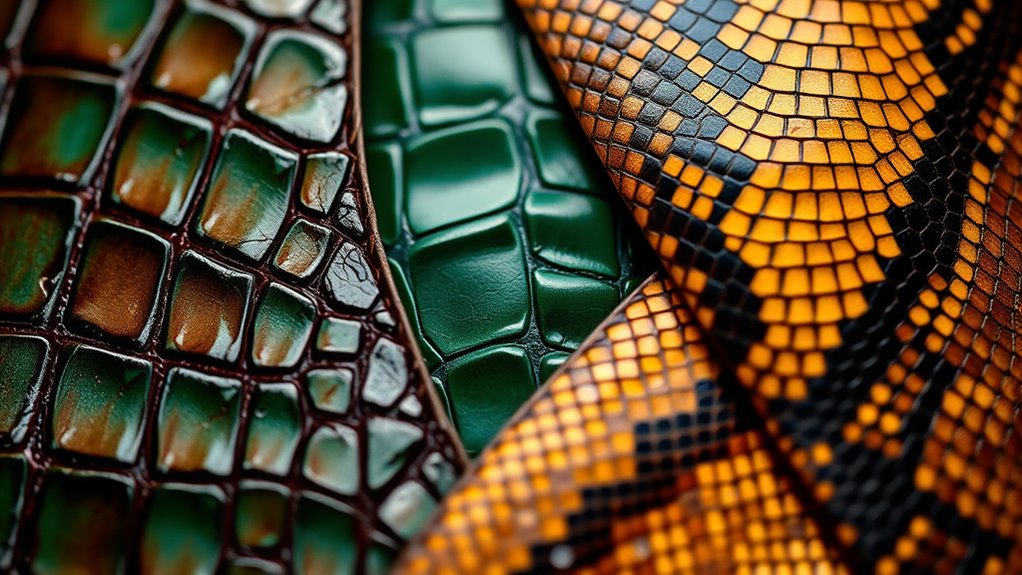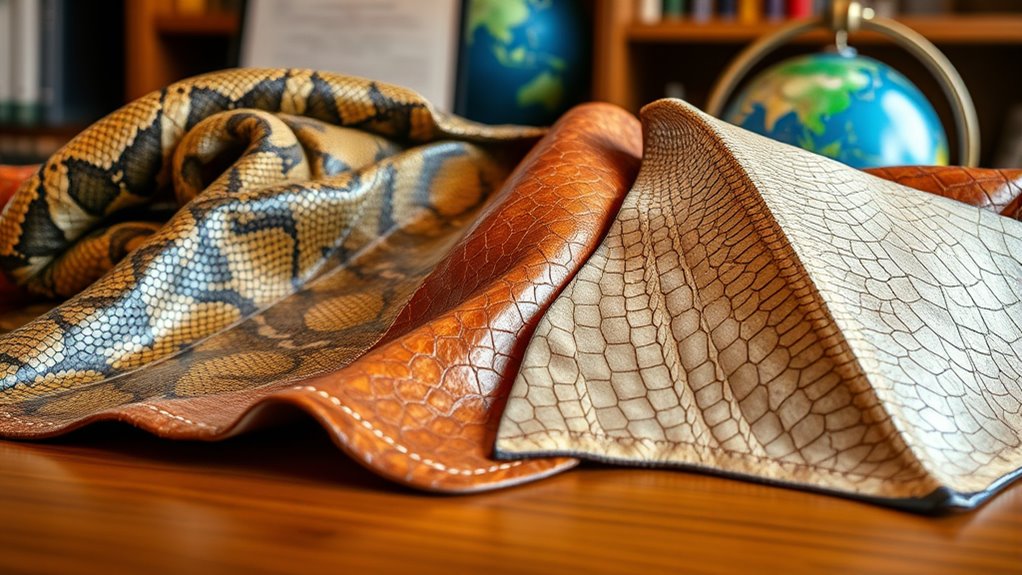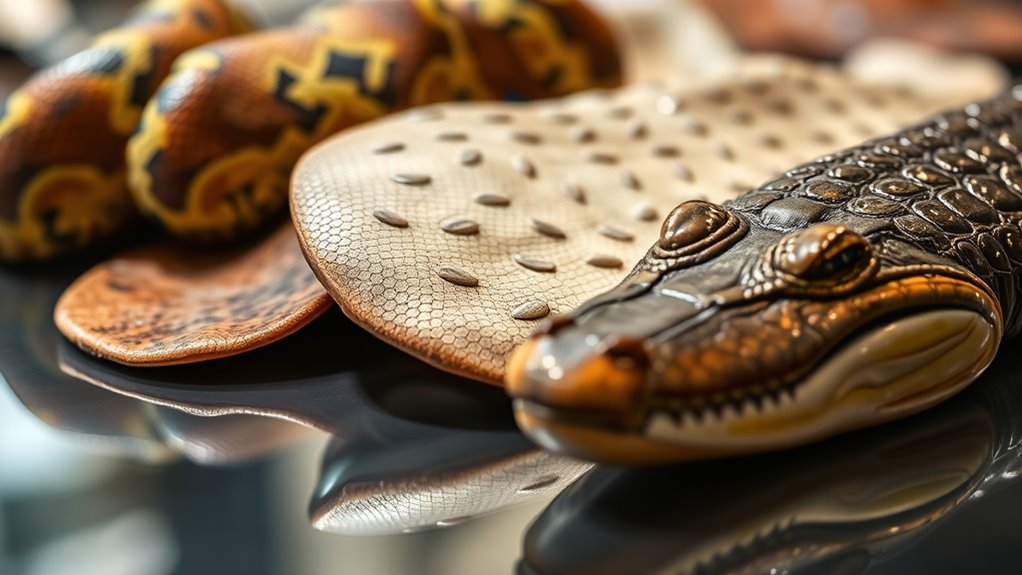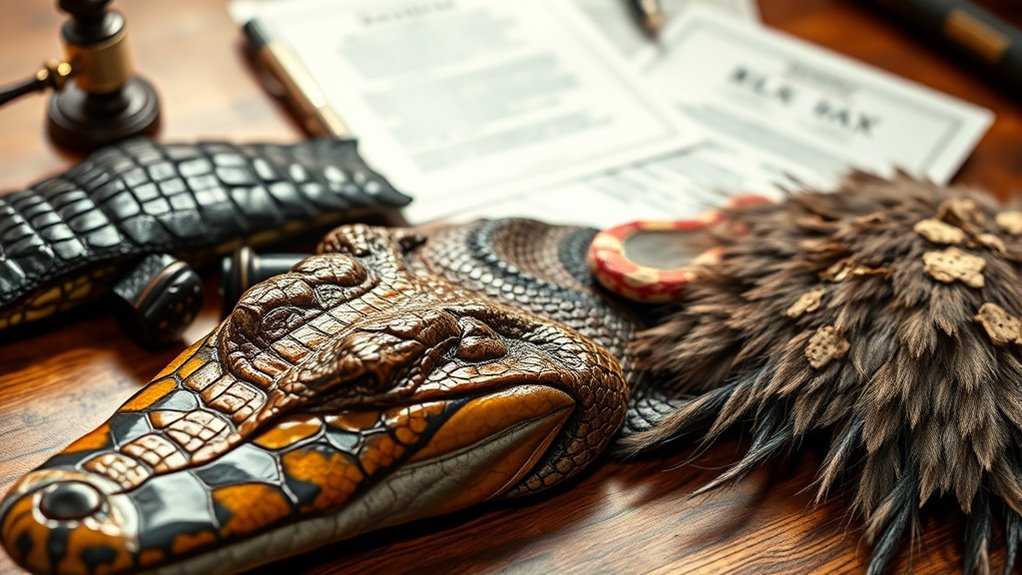Exotic skins come from rare animals like snakes, crocodiles, and ostriches, prized for their unique textures and cultural significance. Their trade is regulated by international laws such as CITES and national rules to protect wildlife and guarantee sustainable sourcing. Ethical concerns focus on animal welfare and illegal poaching. Responsible sourcing and transparency are key for buyers and producers. To understand how legality and ethics shape this industry, there’s much more you can explore ahead.
Key Takeaways
- Exotic skins are derived from rare animals like snakes, crocodiles, and ostriches, with cultural and historical significance.
- Their legality is governed by international agreements like CITES, requiring permits to ensure sustainable and ethical trade.
- Ethical concerns focus on animal welfare, humane harvesting, and preventing illegal poaching and smuggling.
- Consumers are encouraged to choose brands with transparent, certified sourcing to support responsible practices.
- Trends are shifting toward sustainable alternatives, including lab-grown and plant-based skins, driven by environmental and ethical considerations.
What Are Exotic Skins and Why Are They Valued?

Exotic skins refer to the hides and patterns of rare or unusual animals used in fashion and accessories. These materials carry significant cultural importance in many societies, symbolizing status, tradition, or craftsmanship. Their rarity value makes them highly sought after, as they are not easily accessible or replicated. Collectors and designers prize these skins for their uniqueness and the prestige they confer. Each exotic material often holds deep cultural significance, reflecting a history or belief system of the region it originates from. The limited supply of certain animals enhances their exclusivity, making products crafted from these skins more valuable. This blend of cultural meaning and rarity drives their desirability in the luxury market, despite ongoing debates about ethics and conservation. Additionally, the biological diversity of species used in exotic skins highlights the importance of sustainable practices in the industry.
Common Types of Exotic Materials in Fashion and Collecting

Have you ever wondered which materials dominate the world of exotic fashion? Popular choices include snake, crocodile, and ostrich skins, known for their distinctive textures and durability. You’ll find that many of these materials come from rare species, making them highly sought after by collectors and designers alike. Historically, these skins have been used for centuries, symbolizing wealth and status in various cultures. For example, crocodile leather dates back to ancient Egypt, while ostrich feathers have been prized since the Renaissance. Each type of exotic material carries its own story and cultural significance, adding to its allure. Understanding these common materials helps you appreciate their craftsmanship and the tradition behind their use in luxury fashion and collecting. Additionally, the legality and ethics of sourcing these skins continue to influence their availability and desirability in the market.
Legal Frameworks Governing the Trade of Exotic Skins

The trade of exotic skins is tightly regulated by a complex web of international, national, and regional laws designed to guarantee sustainable harvesting. These frameworks prioritize wildlife conservation and respect cultural significance. You should be aware of key regulations like:
- CITES (Convention on International Trade in Endangered Species), which controls the movement of endangered species.
- National wildlife laws that set quotas and licensing requirements.
- Regional trade agreements that restrict or permit certain species.
- Cultural protections that recognize traditional uses and heritage.
Implementing strict enforcement measures ensures these laws effectively prevent illegal poaching and promote sustainable practices. These laws aim to prevent illegal poaching, promote sustainable practices, and balance economic interests with conservation efforts. By understanding these legal frameworks, you help support responsible trade that respects both wildlife conservation and cultural significance.
International Agreements and Their Impact on Exotic Skin Trade

How do international agreements shape the exotic skin trade? They set vital standards through CITES regulations, which regulate the international movement of protected species and their skins. These agreements aim to prevent illegal poaching and trade by requiring permits and documentation for legal transactions. International enforcement guarantees countries comply with these rules, helping to curb illegal activities. When you buy exotic skins, understanding these agreements helps you recognize legal sources and avoid supporting illegal markets. CITES regulations directly influence supply chains, making it harder for illegal traders to operate across borders. As a result, international cooperation becomes essential in protecting endangered species and maintaining sustainable trade practices. Your awareness of these agreements can contribute to responsible consumption and conservation efforts worldwide. International cooperation plays a crucial role in effective enforcement and compliance across nations.
Ethical Concerns Surrounding Exotic Skin Sourcing

When sourcing exotic skins, you need to contemplate animal welfare and whether the practices are humane. You might also face challenges ensuring that trade remains legal and ethical across different countries. These concerns require careful attention to protect both animals and legitimate markets. Additionally, understanding the legal regulations surrounding exotic skin trade is essential for compliance and ethical sourcing.
Animal Welfare Considerations
While the allure of exotic skins often masks the ethical dilemmas involved, sourcing these materials raises serious animal welfare concerns. You should consider how the pursuit of exotic skins impacts wildlife conservation and animal rights.
Here are key issues to keep in mind: 1. Many animals are caught or farmed under inhumane conditions, causing unnecessary suffering. 2. Overharvesting can threaten species’ survival, disrupting ecosystems. 3. Some animals are killed solely for their skins, disregarding their intrinsic value. 4. The demand for exotic skins fuels illegal poaching and trade, further endangering wildlife. 5. Promoting awareness about responsible sourcing can help protect wildlife populations and ensure ethical practices.
Legal Trade Challenges
Legal trade challenges surrounding exotic skins pose significant ethical concerns because, despite regulations, illegal harvesting and smuggling continue to thrive. Unregulated markets enable the illegal trafficking of rare species, often driven by high demand and profit. These illicit activities undermine conservation efforts and threaten species with extinction. Traders exploit loopholes, bypassing legal channels and avoiding oversight, which makes detecting and stopping illegal trafficking difficult. Even with strict laws, enforcement can be inconsistent, allowing illegal sourcing to persist. This perpetuates a cycle where endangered animals are exploited for exotic skins, raising moral questions about consumer responsibility. Addressing these challenges requires stronger international cooperation, improved monitoring, and stricter penalties to combat illegal trafficking and protect vulnerable species from unethical exploitation. Studies also indicate that regulatory efforts are sometimes insufficient to prevent illegal trade, highlighting the need for comprehensive strategies.
How to Identify and Verify Authentic Exotic Skins

Authentic exotic skins have distinct characteristics that set them apart from faux or misrepresented materials. To verify authenticity, you should use reliable authentication methods and focus on counterfeit detection. Here are steps to help you identify genuine exotic skins:
- Examine the texture – authentic skins have unique grain patterns and a natural feel.
- Check the markings – look for consistent, characteristic markings specific to each species.
- Inspect the edges – genuine skins often have clean, precise cuts, unlike synthetic imitations.
- Seek expert authentication – consult professionals or reputable sources to confirm the material’s origin.
- Understand the legal considerations involved in purchasing exotic skins, as laws vary by region and species, ensuring you remain compliant and ethical.
Using these methods ensures you’re purchasing authentic exotic skins and helps avoid counterfeit products. Always trust reputable sellers and double-check with specialists when in doubt.
Responsible Practices for Consumers and Producers

When purchasing exotic skins, your choices directly impact animal welfare and industry sustainability. To promote responsible practices, prioritize brands that emphasize ethical sourcing and transparency. Supporting reputable producers aligns with luxury branding standards and respects cultural symbolism tied to certain skins. By doing so, you help reduce illegal trade and encourage sustainable harvesting.
| Responsible Practice | Impact |
|---|---|
| Choose certified sources | Ensures ethical, legal procurement |
| Educate yourself | Understand cultural significance and ethics |
| Support transparency | Promotes industry accountability |
Your informed decisions foster a more ethical exotic skin industry, respecting cultural traditions while ensuring animal welfare. Responsible practices from both consumers and producers help preserve the integrity of luxury branding without compromising ethical standards.
The Future of Exotic Skins: Trends and Sustainability

As consumer preferences shift toward sustainability, you’ll notice new materials gaining popularity in exotic skin products. Regulatory changes are also shaping the industry, pushing for more ethical practices. Staying informed about these trends can help you make smarter, more responsible choices moving forward. Additionally, understanding personality traits can aid in making well-rounded decisions about ethical consumption and personal values.
Emerging Sustainable Materials
Emerging sustainable materials are transforming the future of exotic skins by offering environmentally responsible alternatives that do not compromise on quality or beauty. These eco friendly innovations provide sustainable alternatives to traditional skins, reducing environmental impact. Here are some exciting developments:
- Lab-grown skins – Cultivated in labs, they mimic real exotic skins without harming animals.
- Plant-based leathers – Made from materials like pineapple leaves or mushroom mycelium, offering durability and unique textures.
- Recycled materials – Repurposed leather scraps and synthetic fibers reduce waste and promote sustainability.
- Bioengineered skins – Using biotechnology, researchers develop skins that are both sustainable and visually stunning.
Additionally, understanding the signs of spoilage in natural materials ensures that only high-quality, safe skins are used in luxury products.
These innovations pave the way for responsible luxury, aligning industry practices with environmental values.
Consumer Demand Shifts
Growing consumer awareness about environmental issues and animal welfare is reshaping the demand for exotic skins. You’ll notice shifts in consumer preferences, with more buyers seeking ethically sourced or sustainable alternatives. This change influences market fluctuations, causing traditional exotic skin markets to adapt or decline. As more people prioritize transparency and sustainability, demand for certain skins may decrease, while others gain popularity due to ethical considerations. Your purchasing choices now reflect not only personal style but also values around conservation and animal rights. Brands responding to these trends are exploring innovative materials and transparent supply chains to meet evolving preferences. Overall, these consumer demand shifts are driving the industry toward more responsible practices, shaping the future landscape of exotic skins in fashion and accessories.
Regulatory Developments Ahead
Regulatory developments are shaping the future landscape of exotic skins by implementing stricter laws and international agreements aimed at conservation and ethical sourcing. You can expect increased trade restrictions as governments and organizations work together to protect endangered species. These changes focus on ensuring sustainable practices and reducing illegal trade. Here are some key trends to watch:
- Tighter import/export controls to prevent illegal sourcing.
- Broader bans on specific species to promote conservation.
- Enhanced traceability requirements for exotic skins.
- International cooperation to enforce trade restrictions effectively.
These regulatory developments will likely make it more challenging to trade exotic skins, emphasizing sustainability and ethical sourcing. Staying informed about upcoming laws and agreements helps you navigate the evolving landscape and supports responsible practices.
Frequently Asked Questions
Are There Any Alternative Materials That Mimic Exotic Skins Ethically?
You’re wondering if there are ethical alternatives that mimic exotic skins. Yes, synthetic leather and eco-friendly alternatives provide realistic textures without harming animals. These materials are often more sustainable, cruelty-free, and can be designed to resemble the look and feel of genuine exotic skins. By choosing these options, you support ethical fashion and reduce environmental impact, making it easier to enjoy stylish, exotic-inspired accessories responsibly.
How Do Customs Authorities Detect Illegal Exotic Skin Shipments?
Customs authorities detect illegal exotic skin shipments through detailed shipment inspections and wildlife forensics. They analyze packaging, labels, and shipping documents for inconsistencies. Wildlife forensic experts examine samples to identify species and verify legality. Advanced tools like DNA analysis help detect smuggling. You should be aware that these measures are designed to prevent illegal trade, ensuring only legal, ethically sourced skins pass through customs undetected.
What Are the Penalties for Illegal Exotic Skin Trade?
You face serious penalties if caught trading illegal exotic skins. These include hefty fines, imprisonment, and potential bans from future trade, all aimed at supporting wildlife conservation. Legal enforcement agencies work diligently to combat these crimes, emphasizing the importance of adhering to laws protecting endangered species. By understanding these penalties, you recognize the significance of respecting regulations and helping preserve biodiversity through lawful trade practices.
Can Exotic Skins Be Sustainably Sourced Without Harming Species?
Picture exotic skins as delicate tapestries woven by nature’s own hand. You can achieve this without tearing the fabric by supporting sustainable harvesting practices that prioritize species conservation. Responsible sourcing guarantees that the beauty of these skins doesn’t come at the expense of the species’ future. By choosing suppliers committed to ethical practices, you help preserve these extraordinary creatures while enjoying the elegance of their natural patterns.
How Does Consumer Demand Influence Exotic Skin Harvesting Practices?
Your consumer preference and market demand heavily influence exotic skin harvesting practices. When you prioritize ethically sourced or sustainable options, it encourages producers to adopt better practices. Conversely, high demand for rare or luxurious skins can lead to overharvesting and unethical treatment of species. By making conscious choices and supporting responsible brands, you help shift the industry toward more sustainable methods and reduce harmful impacts on wildlife populations.
Conclusion
Exploring the world of exotic skins is like walking a tightrope — it’s complex, delicate, and demands awareness. By understanding the legal and ethical landscape, you can make responsible choices that protect both animals and your integrity. Remember, your decisions hold the power to shape the future of this industry, steering it away from disaster and into sustainable innovation. Stay informed, stay ethical, and let your awareness be the beacon that guides a more compassionate world.









